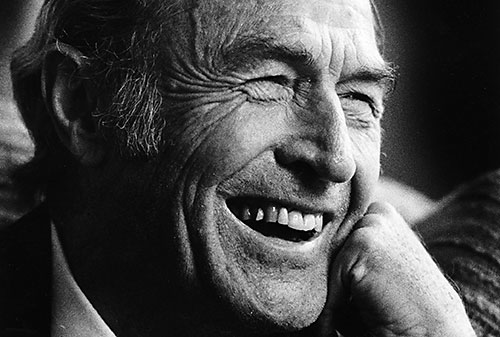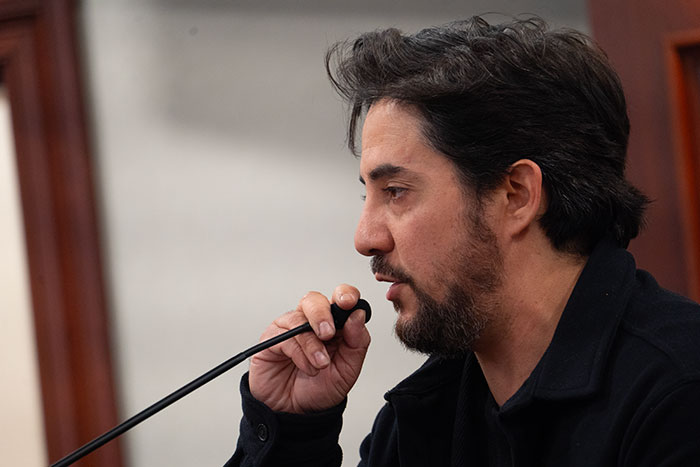Distinctive grand marshals of parades past

by Rebecca Norden-Bright | intern@claremont-courier.com
In light of the city of Claremont cancelling all in-person celebrations for the Fourth of July this year, the COURIER dug through the archives to look into traditions from previous years.
Every year, the city-appointed Blue Ribbon Committee has chosen an individual or individuals who have demonstrated a commitment to the community to march at the front of the parade as Grand Marshal.
This tradition has continued since the 1950s, and since there was no Grand Marshal this year, the COURIER has highlighted some of the city’s most compelling previous marshals.
Elijah Wilson Lyon, 1955, 1963, 1985
Elijah Wilson Lyon is best known for his tenure as president of Pomona College from 1941 to 1969, as well as for writing The History of Pomona College, 1887-1969 in 1977.
Born in Mississippi in 1904, Mr. Lyon attended the University of Mississippi, where he was senior class president and editor of the college newspaper, earning him a position as a Rhodes Scholar after graduation. He taught briefly at Louisiana Polytechnic Institute and Colgate University until his appointment at Pomona.
His daughter, Elizabeth Lyon Webb, recalls taking the Santa Fe Chief train to Claremont in 1941 at age five when her father accepted the presidency of Pomona three months after his 37th birthday. She wrote and published a book in 2009 about her father’s life called The Education of a Mississippian: The Early Life of E. Wilson Lyon.
According to an obituary in the Los Angeles Times, Pomona’s endowment rose from $3.5 million to more than $22 million and its student body swelled from 790 to 1,200 during Mr. Lyon’s stint as president.
Additionally, Mr. Lyon supported the physical expansion of the campus, and oversaw the construction of nine new dormitories and academic buildings including the Seaver Science Complex.
After retiring from his position, Mr. Lyon continued to be prolific in writing history. Pomona College honored his impressive record in 1969 by establishing a professorship in his honor and naming a new dormitory, E. Wilson Lyon Court, after him upon his death in 1989.
He was named Grand Marshal three times, more than any other individual in Claremont’s history.
Mrs. Elva Miller, 1967
Mrs. Elva Miller was a singer known professionally as Mrs. Miller. She recorded six albums throughout her career and was an active member of the community in Claremont.
Ms. Miller was born Elva Ruby Connes in Missouri in 1907 and moved to Claremont after marrying John Richardson Miller, a professional investor nearly 40 years her senior, in 1934.
A traditional housewife, she began taking music classes at Pomona College and recording her own albums as a hobby. Initially, she sang mostly classical, gospel and children’s music.
In 1965, however, she began to attract more attention and signed with Capitol Records, where she sang covers of well-known pop and rock ‘n’ roll songs in an amateurish, operatic style.
Producers often played her off as a joke, choosing her worst takes in order to advertise her as a comedic act. Though unclear whether Mrs. Miller was in on the joke initially, she later seemed to embrace the characterization and brought comedy to her public performances.
In 1967, Ms. Miller told a reporter with the Associated Press that “Capitol Records created the angle that ‘she’s so bad that she’s good.’ Or, it’s what you call ‘camp.’ But still that doesn’t explain why so many records were sold. It’s true that the album was a gag. But it’s also true that I have drawers full of letters from young people saying, ‘We think it’s wonderful that you are singing our songs.’”
A profile of Mrs. Miller in the Fall 2019 edition of the Pomona College Magazine describes her as “the priggish society matron, the antithesis of all things with-it and groovy, practically begging for her smug derision.”
Despite this negative characterization, Mrs. Miller was very popular during her career peak in the mid- to late-1960s. She performed at the Hollywood Bowl, on the Ed Sullivan Show and for US servicemen in Vietnam.
However, she waned in popularity and was dropped from Capitol’s roster in 1968, producing her last album in 1970 and officially retiring in 1973.
She continued to be active in local charity work throughout her life, making her a well-known and well-respected member of the community. She died in 1997.
Col. John Stavast, 1973
Although Colonel John Stavast lived just a short time in Claremont, he was well-known after being captured in Vietnam in 1967 and then released in 1972.
Col. Stavast, born in 1926 in Colorado, entered the Army in 1944 as an Aviation Cadet, was honorably discharged in 1946 and then joined the Air Force as a pilot in 1949.
In 1966, he married Shirley Lee Metzger, a school teacher at Claremont Presbyterian Church. Shirley was a Claremont resident but met her husband at Laon Air Base in France where she briefly held a teaching position.
In September 1967, Col. Stavast’s plane was shot down by a missile near Hanoi. He was captured and held as a prisoner of war, along with his backseater, and was tortured continuously for a week. Col. Stavast had suffered broken bones in his back, arms and legs, a skull fracture and a fractured jaw. Both men survived, however, and were released in March 1972.
President Richard Nixon was credited with the men’s release. Mrs. Stavast wrote to the president in 1973: “Because of your perseverance for a just peace, John’s and my separation was not in vain. May God’s light confirma to shine on you and yours in the coming years,” as published in the New York Times.
Col. Stavast was awarded grand marshal status upon his release, and finally retired from the Air Force as a Colonel in 1980 as a recipient of “three Silver Stars, two Legions of Merit, three Distinguished Flying Crosses, two Purple Hearts, the Bronze Star with ‘V’ (for valor) device, and six Air Medals.”
After retiring, he and his wife moved to Austin, Texas, where he lived until his death in 2004.
Jerry Voorhis, 1981
Jerry Voorhis, a five-term Democratic congressman, is known for his liberal voting record and for his defeat in 1946 by novice Republican and future President Richard Nixon. He lived in Claremont from 1972 until his death in 1984.
He was born in Ottawa, Kansas in 1901 and graduated from Yale in 1923. He then pursued a master’s degree at the Claremont Colleges. In 1928, he became the headmaster of the Voorhis School for Boys in San Dimas, and from 1930 to 1935 served as a visiting lecturer at Pomona College.
In 1936, Mr. Voorhis ran for Congress in the Los Angeles area. An ardent New Dealer, he had previously been a registered socialist.
He served five terms as a representative from California’s old 12th District. He had one of the most liberal voting records in Congress at the time.
Mr. Voorhis lost his bid for reelection in 1946, in an election that the New York Times describes as pitting “against each other two men who could scarcely have been ideologically further apart.”
Mr. Voorhis later apologized for losing the election, implying that he blamed himself for President Nixon’s rise to power.
After the loss, Mr. Voorhis retired from politics completely and began a new career as executive director of the Cooperative League of the USA, a position he held until his retirement in 1967.
He moved to Claremont and lived the rest of his life at Claremont Manor.
T. Willard Hunter, 1987
T Willard Hunter is known for his role in reviving the tradition of Fourth of July oratory and founding Claremont’s Speakers Corner program in 1977, a tradition which now bears his name.
Born in 1915 in Idaho and raised in Northfield, Minnesota, Hunter was a talented public speaker from a young age. He was a debate champion at Carleton College, and then briefly attended Harvard Law School before transferring to Andover Newton Theological School to pursue a religious path.
For 18 years, he traveled around the country to spread the philosophy of the Moral Re-Armament Movement, a movement which sought to deter war through “spiritual and moral reawakening.”
He then worked in higher education for many years, holding administrative positions at Macalester College, Claremont Graduate School and the Claremont School of Theology.
Rev. Hunter became an ordained Congregational minister and frequently preached at churches throughout California and the nation. His passion was public oratory, and he revived the tradition of giving Fourth of July speeches in Claremont.
He spoke often about America’s founding principles and could recite the Declaration of Independence and the Bill of Rights. In 1982, he set a Guinness World Record when he spoke for 34 hours and 8 minutes outside Independence Hall in Philadelphia for the Fourth of July.
Rev. Hunter died in 2009 at the age of 93.
[Rebecca Norden-Bright is a sophomore at Bowdoin College in Brunswick, Maine, where she studies government and serves as the news editor for the Bowdoin Orient. Ms. Norden-Bright, a Claremont resident, grew up in Upland, lives in Claremont now and in her spare time enjoys hiking.]











0 Comments